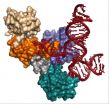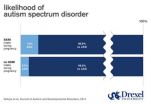(Press-News.org) CHAMPAIGN, Ill. — Children who are physically fit have faster and more robust neuro-electrical brain responses during reading than their less-fit peers, researchers report.
These differences correspond with better language skills in the children who are more fit, and occur whether they're reading straightforward sentences or sentences that contain errors of grammar or syntax.
The new findings, reported in the journal Brain and Cognition, do not prove that higher fitness directly influences the changes seen in the electrical activity of the brain, the researchers say, but offer a potential mechanism to explain why fitness correlates so closely with better cognitive performance on a variety of tasks.
"All we know is there is something different about higher and lower fit kids," said University of Illinois kinesiology and community health professor Charles Hillman, who led the research with graduate student Mark Scudder and psychology professor Kara Federmeier. "Now whether that difference is caused by fitness or maybe some third variable that (affects) both fitness and language processing, we don't know yet."
The researchers used electroencephalography (EEG), placing an electrode cap on the scalp to capture some of the electrical impulses associated with brain activity. The squiggly readouts from the electrodes look like seismic readings captured during an earthquake, and characteristic wave patterns are associated with different tasks.
These patterns are called "event-related potentials" (ERPs), and vary according to the person being evaluated and the nature of the stimulus, Scudder said.
For example, if you hear or read a word in a sentence that makes sense ("You wear shoes on your feet"), the component of the brain waveform known as the N400 is less pronounced than if you read a sentence in which the word no longer makes sense ("At school we sing shoes and dance," for example), Scudder said.
"We focused on the N400 because it is associated with the processing of the meaning of a word," he said. "And then we also looked at another ERP, the P600, which is associated with the grammatical rules of a sentence." Federmeier, a study co-author, is an expert in the neurobiological basis of language. Her work inspired the new analysis.
The researchers found that children who were more fit (as measured by oxygen uptake during exercise) had higher amplitude N400 and P600 waves than their less-fit peers when reading normal or nonsensical sentences. The N400 also had shorter latency in children who were more fit, suggesting that they processed the same information more quickly than their peers.
Most importantly, the researchers said, these differences in brain activity corresponded to better reading performance and language comprehension in the children who were more fit.
"Previous reports have shown that greater N400 amplitude is seen in higher-ability readers," Scudder said.
"Our study shows that the brain function of higher fit kids is different, in the sense that they appear to be able to better allocate resources in the brain towards aspects of cognition that support reading comprehension," Hillman said.
More work must be done to tease out the causes of improved cognition in kids who are more fit, Hillman said, but the new findings add to a growing body of research that finds strong links between fitness and healthy brain function.
Many studies conducted in the last decade, on children and older adults, "have repeatedly demonstrated an effect of increases in either physical activity in one's lifestyle or improvements in aerobic fitness, and the implications of those health behaviors for brain structure, brain function and cognitive performance," Hillman said.
INFORMATION:
The National Institute of Child Health and Human Development at the National Institutes of Health supported this research.
Editor's notes: To reach Charles Hillman, call 217-244-2663; email chhillma@illinois.edu.
To reach Mark Scudder, email mscudde2@illinois.edu.
The paper, "The Association Between Aerobic Fitness and Language Processing in Children: Implications for Academic Achievement," is available online or from the U. of I. News Bureau.
Brain signals link physical fitness to better language skills in kids
2014-06-03
ELSE PRESS RELEASES FROM THIS DATE:
Palmer amaranth threatens Midwest farm economy, researchers report
2014-06-03
CHAMPAIGN, Ill. — An invasive weed that has put some southern cotton farmers out of business is now finding its way across the Midwest – and many corn and soybean growers don't yet appreciate the threat, University of Illinois researchers report.
Palmer amaranth (Amaranthus palmeri), a flowering plant native to the Sonoran desert and southwest United States, has a laundry list of traits that make it a fierce competitor on the farm, said Aaron Hager, a University of Illinois crop sciences professor.
Palmer amaranth germinates throughout much of the growing season, starts ...
Toxic computer waste in the developing world
2014-06-03
As the developing world continues to develop, standards of living and access to technology increases. Unfortunately, as personal computers, laptops and mobile phones become increasingly common so the problem of recycling and disposal of such devices when they become technologically obsolete rises too, according to research published in the International Journal of Environmental Technology and Management.
Neelu Jain of the PEC University of Technology, in Chandigarh and Pamela Chawla of the Surya World, Surya World Technical Campus in Punjab, India, have estimated the ...
Nano-platform ready: Scientists use DNA origami to create 2-D structures
2014-06-03
Scientists at New York University and the University of Melbourne have developed a method using DNA origami to turn one-dimensional nano materials into two dimensions. Their breakthrough, published in the latest issue of the journal Nature Nanotechnology, offers the potential to enhance fiber optics and electronic devices by reducing their size and increasing their speed.
"We can now take linear nano-materials and direct how they are organized in two dimensions, using a DNA origami platform to create any number of shapes," explains NYU Chemistry Professor Nadrian Seeman, ...
Scientists capture most detailed images yet of tiny cellular machines
2014-06-03
MADISON, Wis. — A grandfather clock is, on its surface, a simple yet elegant machine. Tall and stately, its job is to steadily tick away the time. But a look inside reveals a much more intricate dance of parts, from precisely-fitted gears to cable-embraced pulleys and bobbing levers.
Like exploring the inner workings of a clock, a team of University of Wisconsin-Madison researchers is digging into the inner workings of the tiny cellular machines called spliceosomes, which help make all of the proteins our bodies need to function. In a recent study published in the journal ...
Preventive services by medical and dental providers and treatment outcomes
2014-06-03
Alexandria, Va., USA – The International and American Associations for Dental Research (IADR/AADR) have published a paper titled "Preventive Services by Medical and Dental Providers and Treatment Outcomes." Nearly all state Medicaid programs reimburse non-dental primary care providers (nDPCPs) for providing preventive oral health services to young children; yet, little is known about how treatment outcomes compare to children visiting dentists. This study compared the association between the provider of preventive services (nDPCP, dentist or both) to Medicaid-enrolled children ...
New Ichthyosaur graveyard found
2014-06-03
Boulder, Colo., USA – In a new study published in the Geological Society of America Bulletin, geoscientists Wolfgang Stinnesbeck of the University of Heidelberg and colleagues document the discovery of forty-six ophthalmosaurid ichthyosaurs (marine reptiles). These specimens were discovered in the vicinity of the Tyndall Glacier in the Torres del Paine National Park of southern Chile. Among them are numerous articulated and virtually complete skeletons of adults, pregnant females, and juveniles.
Preservation is excellent and occasionally includes soft tissue and embryos. ...
Miniature digital zenith telescope for astronomy and geoscience
2014-06-03
As a kind of ground-based optical astrometric instrument, zenith telescope observes stars near zenith, which substantially reduces the influence of normal atmospheric refraction. Its high-precision observations can be used to calculate astronomical latitude and longitude, which are mainly applied in mobile measurement for deflection of the vertical, long-term measurement for the variations of the vertical, and related researches of astronomical seismology. Utilizing CCD camera, high-precision tiltmeter and other new technologies and devices, Chinese researchers have successfully ...
Image release: A violent, complex scene of colliding galaxy clusters
2014-06-03
Astronomers using the Karl G. Jansky Very Large Array (VLA) and the Chandra X-Ray Observatory have produced a spectacular image revealing new details of violent collisions involving at least four clusters of galaxies. Combined with an earlier image from NASA's Hubble Space Telescope (HST), the new observations show a complex region more than 5 billion light-years from Earth where the collisions are triggering a host of phenomena that scientists still are working to understand.
The HST image forms the background of this composite, with the X-ray emission detected by Chandra ...
In utero exposure to antidepressants may influence autism risk
2014-06-03
PHILADELPHIA (June 2, 2014) – A new study from researchers at Drexel University adds evidence that using common antidepressant medications during pregnancy may contribute to a higher risk of autism spectrum disorders (ASD) in children, although this risk is still very small.
Results from past studies of prenatal use of selective serotonin reuptake inhibitors (SSRIs) and ASD risk have not been consistent. An ongoing challenge in this line of research is trying to tease apart potential effects of the medication on risk from the effects associated with the condition for ...
Breaking down barriers
2014-06-03
The Gobi-Steppe Ecosystem is world renowned for its populations of migratory ungulates, which cover great distances in search of forage. Researchers at the Research Institute of Wildlife Ecology at Vetmeduni Vienna have documented, that in just one year an individual wild ass can range over an area of 70,000 km2. "Wild asses and gazelles have to be permanently on the move and travel very long distances to find enough food. Rainfall is highly variable in this region. As a consequence pastures are patchy and unpredictable in space and time," explains Petra Kaczensky, one ...






